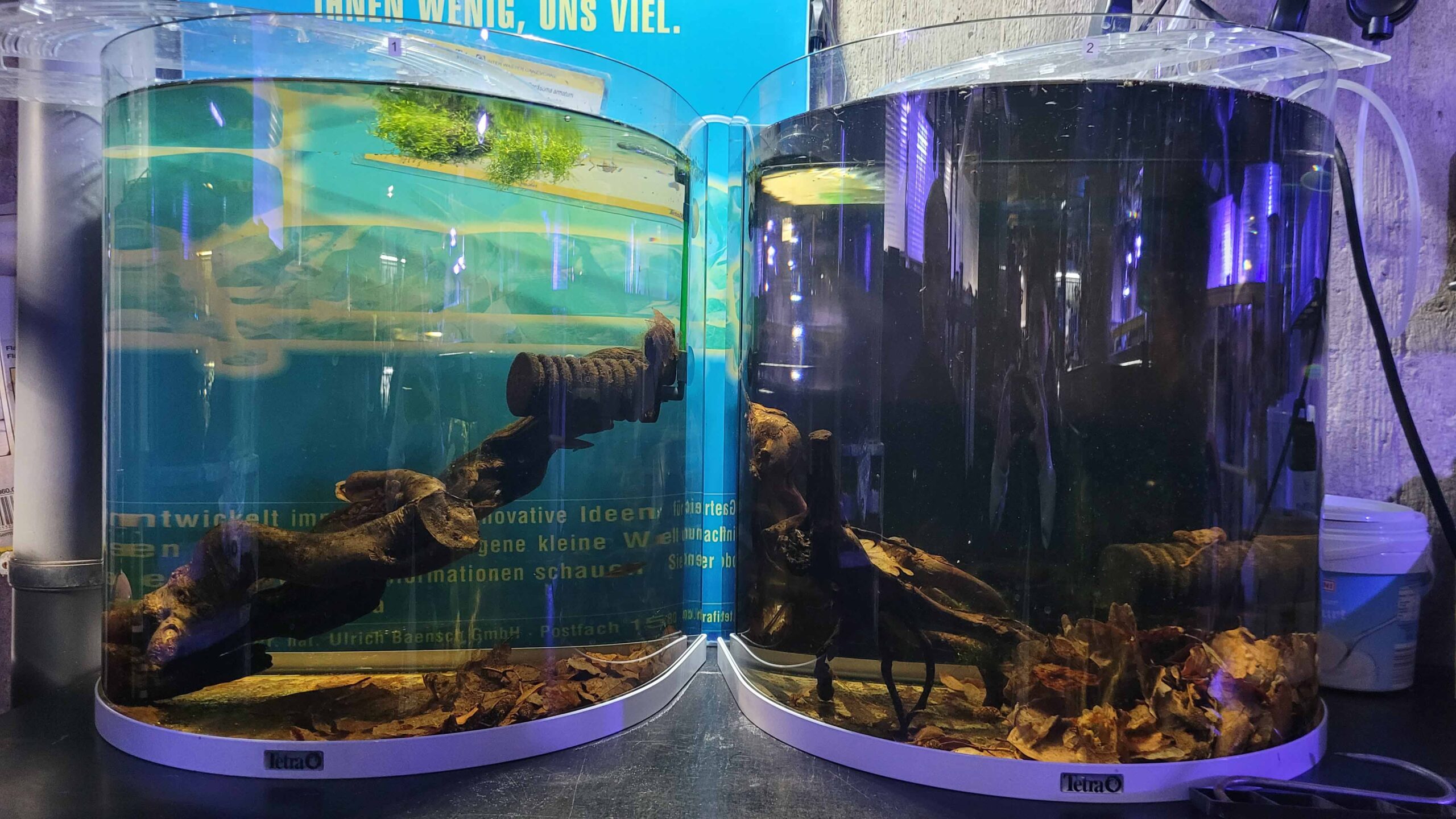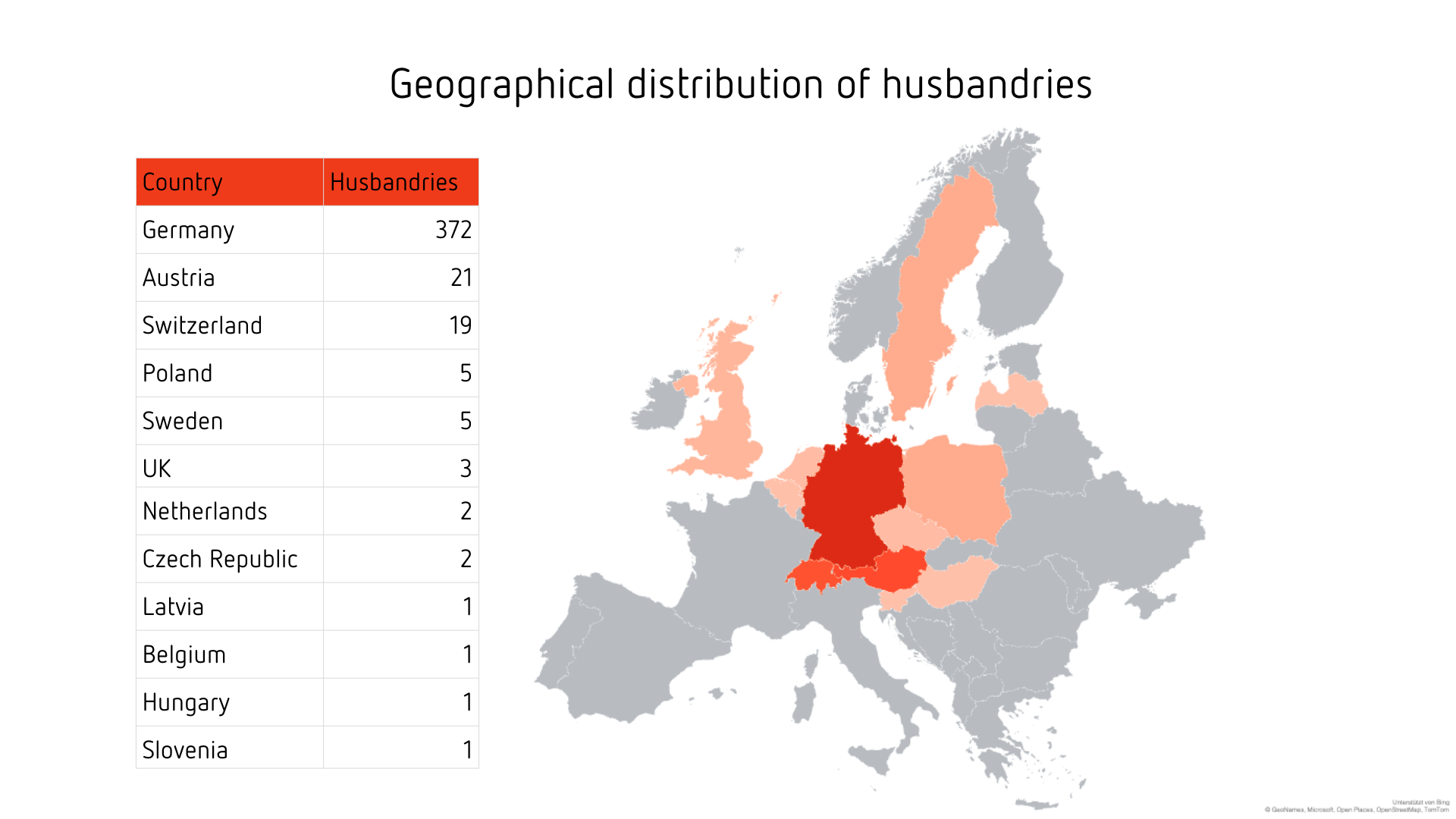
Animal population overview 2/2025 – Breeding by the numbers
Tags
5,376 animals from 32 species or subspecies, cared for by 257 participants in 433 facilities – that is Citizen Conservation’s animal inventory as of 1 November 2025.
Steady growth
This means that the number of people participating in CC has risen almost linearly over the past six months. Two years ago, on 1 November 2023, there were 175 participants, a year later 214, and now there are 257 participating private animal keepers, zoos, school vivariums and other institutions such as associations, display aquariums, universities and museums. This represents an increase of 43 participants within the last year, a growth of 20%. Once people have acquired a taste for it, they are happy to keep several species for CC, which is why the number of husbandries is higher. It has increased similarly from 230 on 1 November 2023 to 350 a year later and 433 this year, an increase of 83 husbandries or 24% in the past 12 months. 64 % of participants are private keepers, i.e. people who set up aquariums or terrariums at home to breed highly endangered amphibians, fish or reptiles on a voluntary basis, thus contributing to the preservation of these species from extinction and their conservation for the future. A further 16% of participants are zoos, 11% are schools, and 9% are other institutions. In terms of the number of husbandries, zoos account for a slightly higher proportion at 26%, but even then, 52% of the commitment comes from private keepers (schools: 13%, other institutions: 9%). This is in line with expectations – zoos often have the capacity to care for more species than private individuals. CC started with amphibians in 2018, and they currently continue to make up the largest proportion of the species managed, with 19 taxa, followed by 8 fish and 5 reptile species.

A great success for species conservation! The Karlsruhe Zoo has successfully bred the endangered Demonic Poison Frog for the first time.

There were also reports of offspring of Bintan gouramis. Behind the scenes at Osnabrück Zoo, the right conditions are being worked out to successfully breed the animals.

In October, we were delighted to welcome the first offspring of a Huu-Lien tiger gecko within CC.
Target numbers in sight
Scientifically based statistical tools can be used to calculate how many animals are needed in a conservation breeding programme to maintain it for, say, 40 years without a significant decline in the genetic diversity of the original animals. This results in target numbers – sometimes after technically justified modifications – which CC determines for each species and displays on the species pages of our website. We are already close to this target for the Mallorca Midwife Toad, Lake Pátzcuaro Salamander, Rio Pescado Harlequin Toad, Vietnamese Crocodile Newt, Madagascar Rainbowfish and Mangarahara Cichlid.
Reproducers and rebels
Over the past six months, we have successfully bred 22 of our species within CC. For example, the Mallorca Midwife Toad, the two Ambystoma species, the Rio Pescado Harlequin Toad, the Chinese Fire-Bellied Toad, the Fire Salamander, Titicaca Water Frog, Vietnamese Crocodile Newt, Madagascar Rainbowfish, Charco Azul Pupfish, Tiger Limia, and Mangarahara Cichlid. With other species, success has been sporadic or is just beginning, as in the case of the Guimbeaui‘s Day Gecko, where we are delighted to see an increasing number of small geckos hatching.
However, we have not yet had any success with the Loja Marsupial Frog and Smith’s Sabre-Toothed Frog. Unfortunately, we only have very few initial animals of either species. The Nguru Dwarf Chameleon is also proving difficult – while the reproduction of wild-caught animals originating from an impoundment at Schönbrunn Zoo has been successful, their offspring have not yet shown a willingness to reproduce. However, our experts are doing everything they can to ‘crack’ these species as well.
We are particularly pleased with the initial successes with Huu-Lien Tiger Geckos, Demonic Poison Frogs, Cielito, Phantasmal Poison Frogs, San Martín Fringe-limbed Treefrogs and Bintan Gouramis. There is also breaking news regarding Ziegler’s Crocodile Newt: the first larvae have now hatched at a private keeper’s facility, but after the cut-off date – so they will only appear in the next inventory overview on 1 May 2026. However, we hope that the first young animals of these still somewhat difficult species will soon be followed by many more!
Animal population overview 1 November 2025
(You can scroll horizontally in the table.)
| Scientific name | Engl. name | Animals total (m/f/u) | Keepers total | Deaths 05/2025 – 10/2025 (m/f/u) | External delivery 05/2025 – 10/2025 | New offspring 05/2025 – 10/2025 | External arrivals 05/2025 – 10/2025 | Aim (animals, keepers) | status* |
|---|---|---|---|---|---|---|---|---|---|
| Amphibians | |||||||||
| Agalychnis lemur | Lemur Leaf Frog | 64 (12,8,44) | 12 | 18 (5,1,12) | 0 | 47 | 0 | 225, 40 | 29 % |
| Alytes muletensis | Mallorcan Midwife Toad | 806 (72, 94, 640) | 59 | 70 (6,4,60) | 59 | 168 | 0 | 425, 53 | 100 % |
| Ambystoma andersoni | Anderson’s Salamander | 100 (21,23,56) | 17 | 5 (1,3,1) | 58 | 62 | 0 | 225, 40 | 43 % |
| Ambystoma dumerilii | Lake Patzcuaro Salamander | 219 (61,53,105) | 33 | 24 (9,3,12) | 61 | 96 | 0 | 225, 40 | 90 % |
| Atelopus balios | Rio Pescado Stubfoot Toad | 516 (38,46,432) | 24 | 39 (1,2,36) | 25 | 372 | 0 | 225, 32 | 88 % |
| Bombina orientalis | Oriental fire-bellied Toad | 389 (49,38,302) | 27 | 12 (1,1,10) | 45 | 69 | 0 | 225, 60 | 73 % |
| Ecnomiohyla valancifer | San Martín Fringe-limbed Treefrog | 44 (6,13,25) | 2 | 1 (0,0,1) | 0 | 19 | 0 | 225, 56 | 12 % |
| Epipedobates tricolor | Phantasmal Poison Frog | 33 (5,2,26) | 4 | 3 (0,0,3) | 0 | 2 | 0 | 320, 45 | 10 % |
| Gastrotheca lojana | Loja Marsupial Frog | 11 (5,6,0) | 3 | 0 (0,0,0) | 0 | 0 | 0 | 225, 38 | 6 % |
| Ingerophrynus galeatus | Bony-headed Toad | 77 (23,9,45) | 7 | 12 (2,1,9) | 0 | 0 | 0 | 225, 40 | 26 % |
| Minyobates steyermarki | Demonic Poison Frog | 51 (14,20,17) | 9 | 6 (0,3,3) | 0 | 1 | 24 | 110, 20 | 46 % |
| Odontobatrachus smithi | Smith's Toothed Frog | 22 (1,2,19) | 2 | 0 | 0 | 0 | 3 | 225, 38 | 8 % |
| Phyllobates terribilis | Golden Poison Frog | 130 (12,19,99) | 16 | 21 (2,0,19) | 0 | 9 | 45 | 225, 70 | 40 % |
| Salamandra sal. almanzoris | Almanzor Fire Salamander | 30 (10,9,11) | 9 | 2 (0,2,0) | 0 | 0 | 1 | 185, 30 | 23 % |
| Salamandra salamandra (D) | Fire Salamander | 339 (68,54,217) | 47 | 9 (1,1,7) | 0 | 32 | 15 | 330, 90 | 76 % |
| Staurois parvus | Lesser Rock Skipper | 234 (50,44,140) | 4 | 0 (0,0,0) | 0 | 6 | 15 | 500, 10 | 43 % |
| Telmatobius culeus | Titicaca Water Frog | 98 (15,18,65) | 10 | 3 (0,1,2) | 0 | 6 | 22 | 225, 45 | 33 % |
| Tylototriton vietnamensis | Vietnamese Crocodile Newt | 141 (31,50,60) | 29 | 16 (4,7,5) | 0 | 2 | 15 | 185, 30 | 86 % |
| Tylototriton ziegleri | Ziegler’s Crocodile Newt | 54 (18,17,19) | 12 | 1 (1,0,0) | 0 | 0 | 0 | 185, 30 | 35 % |
| Fish | |||||||||
| Bedotia madagascariensis | Madagascar Rainbowfish | 230 (89,65,76) | 15 | 20 (5,10,5) | 0 | 78 | 12 | 192, 16 | 97 % |
| Cyprinodon veronicae | Charco Palma Pupfish | 120 (22,18,80) | 5 | 100 (39,33,28) | 0 | 39 | 0 | 225, 15 | 43 % |
| Limbochromis robertsi | Roberts' Cichlid | 22 (12,10,0) | 4 | 0 (0,0,0) | 0 | 0 | 22 | 215, 16 | 18 % |
| Limia islai | Tiger Limia | 608 (101,145,362) | 21 | 25 (3,5,17) | 0 | 246 | 0 | 2000, 20 | 65 % |
| Parosphromenus bintan | Bintan Gourami | 48 (14,12,22) | 6 | 9 (5,4,0) | 0 | 10 | 6 | 100, 15 | 44 % |
| Ptychochromis insolitus | Mangarahara Cichlid | 500 (54,72,374) | 15 | 75 (3,4,68) | 130 | 209 | 13 | 192, 16 | 97 % |
| Ptychochromis loisellei | Loiselle’s Ptycho | 228 (6,3,219) | 8 | 11 (2,2,7) | 0 | 0 | 0 | 160, 16 | 75 % |
| Ptychochromis oligacanthus | Nosy Be Cichlid | 170 (35,35,100) | 4 | 263 (1,2,260) | 0 | 47 | 0 | 192, 16 | 57 % |
| Reptiles | |||||||||
| Cuora cyclornata | Vietnamese Three-striped Box Turtle | 8 (1,2,5) | 4 | 0 | 0 | 0 | 0 | 100, 50 | 8 % |
| Goniurosaurus huuliensis | Huu Lien Tiger Gecko | 16 (7,8,1) | 7 | 0 | 0 | 1 | 7 | 110, 55 | 14 % |
| Phelsuma guimbeaui | Mauritius Lowland Foerst Day Gecko | 33 (7,13,13) | 9 | 3 (0,3,0) | 0 | 9 | 2 | 110, 55 | 23 % |
| Rhampholeon acuminatus | Nguru Spiny Pygmy Chameleon | 10 (5,5,0) | 2 | 3 (1,2,0) | 0 | 0 | 0 | 215, 36 | 5 % |
| Thamnophis sirtalis tetrataenia | San Francisco Garter Snake | 25 (13,10,2) | 7 | 6 (3,3,0) | 0 | 0 | 12 | 110, 28 | 24 % |
m: male, w: female, u: undetermined sex* Status = mean value of the percentage of the target number of keepers already achieved and the target number of animals



